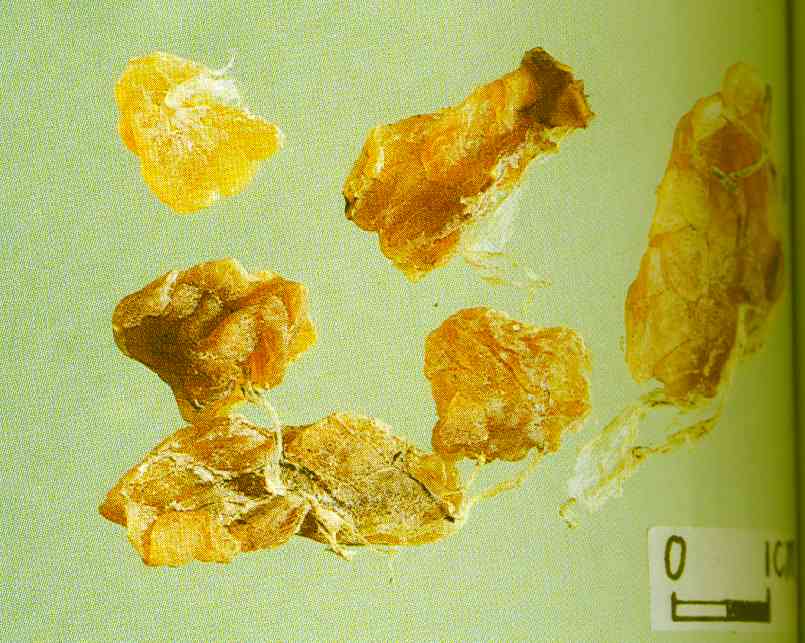| common name | Forest Frog Oviduct Ha Shi Mo |
| alias | Xueha Xue Ha |
| family | Ranidae |
This product is also known as Forest Frog Oviduct, one of the precious Chinese medicinal materials. It has not been recorded in the materia medica of past dynasties. It is a high-grade tonic that has been marketed in modern times. The oil of the forest frog is the dried oviduct of the female forest frog of the frog family. The original animals mainly include the following two species:
- Chinese forest frog (alias forest frog, forest frog oviduct) (Rana temporaria chensinensis David) is an oviparous amphibian. It looks like a frog, with a female body length of 7-9 cm. The male is smaller, with a flat head, equal or slightly wider in length and width, a blunt and round snout, slightly protruding from the lower jaw, and obvious snout scales. The body surface has small nevus particles, and the color changes with the seasons, being brown in autumn and winter, and yellowish brown in summer.
- Heilongjiang forest frog (Rana amurensis Boulenger) is similar in shape to the above species but slightly smaller, with a female body length of 6-7 cm, a flatter head, almost equal in length and width, slightly protruding from the lower jaw, and more obvious snout scales. The skin is rough, with considerable color variation; the dorsal folds or warts on the back or nearby are mostly black spots; the triangular black spots on the tympanic membrane are large and prominent, with black transverse stripes on the back of the limbs. The throat and abdomen have bright vermilion and dark gray mottles.
In the past, there were two specifications: forest frog and forest frog oil, with only the forest frog being sold in Nanyang. Now, mostly forest frog oil is sold.
bubble_chart Morphological Characteristics

is irregularly curved, overlapping thick pieces, slightly ovate, about 2cm long. The surface is yellowish-white to pale yellowish-brown, translucent, with a fatty luster. It often has thin white bark attached and occasionally has residual black eggs. The smell is slightly fishy, the taste is slightly sweet, and it feels sticky when chewed. When soaked in warm water, the volume can expand 10-15 times. The quality is best when the pieces are large and uniform, yellowish-white, oily and glossy, without membranes or black egg pieces.
Counterfeit:
- The oviducts of the Chinese toad (Bufo Bufo gargarizans Cantor) and the black-spectacled toad (Bufo melanostictus Schneider). The shape resembles chicken intestines or coiled strings, connected by white fibrous connective tissue, with different thicknesses at both ends, the thick end being flat and wide, and the thin end being flat or not flat in the middle. The surface is pale yellow or brown, dull, and opaque. It is hard, difficult to break, and feels non-greasy to the touch. It expands 3-7 times when soaked in water. The taste is slightly bitter.
- Frog oil: A counterfeit was discovered by the Mudanjiang Medicinal Materials Station. It is the dried oviduct of a frog from the Ranidae family. The shape is difficult to distinguish from the genuine Hasma; soaking in water for 24 hours can also expand it to 15-20 times. The main difference from the genuine product is that it has a spicy, numbing taste and sticks to the teeth, which can distinguish it from the genuine product.
- Testis of the Alaska pollock from the Gadidae family: It is an irregular blocky connective body, about 2-3cm long and 1.8-4cm thick. Some fragments have green-black dry skin on one side. The surface is yellowish-white, fatty. It is hard and brittle, expanding 0.5-1 times when soaked in water. The smell is fishy.
- Potato imitation: Irregular flat pieces, varying in size, the largest not exceeding the size of a corn kernel, with knife-cut marks on the edges. The surface is grayish-white, translucent, and horny. It is hard, expands when soaked in water, and the surface expansion layer is grayish-white granules, feeling smooth to the touch. The smell is slight, the taste is sweet.
- Sweet potato imitation: The shape and size are similar to potato products. However, the surface is pale brownish-yellow, translucent, and relatively hard. It expands slightly faster than potato products when soaked in water. After soaking, the surface expansion layer is thicker, feeling smooth to the touch. The smell is slight, the taste is sweet.
- To identify genuine Hasma oil, the following points must be grasped: First, the appearance is irregular, overlapping, slightly curved pieces with bark attached and black eggs. Second, soaking in water can expand it more than ten times. Third, it smells slightly fishy and tastes sweet when chewed.
- Identification of toad and frog counterfeits: Frog oviducts closely resemble the genuine product, but a numbing taste indicates frog oviducts; while toad oviducts and Alaska pollock testis have similarities to the genuine product, their expansion when soaked in water can distinguish them.
- Identification of potato and sweet potato counterfeits: The shape can reveal traces of forgery, and soaking in water can distinguish the counterfeit.
bubble_chart Properties and Meridians
Sweet and salty neutral. Act on lung, spleen and kidney meridians.
Tonifying the kidney and replenishing essence, nourishing yin and moistening lung, tonifying the spleen and replenishing qi.
Weak body, post-illness imbalance, palpitation and insomnia, persistent night sweats, pulmonary tuberculosis with cough and wheezing, fatigue, cough, and hemoptysis.

